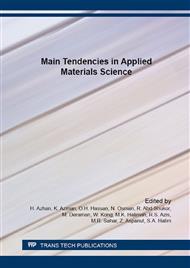[1]
M.M. de Souze Lima and R. Borsali, in: Rodlike Cellulose Microcrystals: Structure, Properties and Applications, Macromolecules Rapid Communications, Vol. 25 (2004), pp.771-787.
DOI: 10.1002/marc.200300268
Google Scholar
[2]
R. Young: Cellulose Structure Modification and Hydrolysis, Wiley, New York (1986), ISBN 0471827614.
Google Scholar
[3]
Nurul Aimi Mohd Zainul Abidin, et. al. (2014), Cellulose Extraction from Hardwood Waste of Resak (Vatica spp. ), Advanced Materials Research Vol. 895(2014) pp.134-137.
DOI: 10.4028/www.scientific.net/amr.895.134
Google Scholar
[4]
R.L. Whistler and J.N. BeMiller: Cellulosic, in Carbohydrates Chemistry for For Food Scienctist, Vol. 1 (1997), p.155.
Google Scholar
[5]
J. George, M.S. Sreekala and S. Thomas: A Review on Interface Modification and Characterization of Natural Fiber Reinforced Plastic Composites, Polymer Engineering and Science, Vol 41/9 (2001), pp.1471-1485.
DOI: 10.1002/pen.10846
Google Scholar
[6]
L. Berglund: Cellulose Based Nanocomposites, in: Natural Fibers, Biopolymers and Biocomposites, Taylor and Francis (2005), pp.807-832.
DOI: 10.1201/9780203508206.ch26
Google Scholar
[7]
Noriean Azraaie, et. al. (2014), X-Ray Diffraction (XRD) Analysis of Cellulose From Banana (Musa acuminata) Pseudo-Stem Waste, Advanced Materials Research Vol. 865(2014) pp.174-177.
DOI: 10.4028/www.scientific.net/amr.895.174
Google Scholar
[8]
A. Chakraborty, M. Sain and M. Kortschot: Reinforcing Potential of Wood Pulp-Derived Microfibres in a PVA matrix, Holzforschung, Vol 59 (2005), pp.102-107.
DOI: 10.1515/hf.2006.010
Google Scholar
[9]
Nur Amira Mamat Razali, et. al. (2013), Preliminary Preparation and Characterization Studies of Cellulose From Merbau (Intsia bijuga), Advanced Materials Research Vol. 620(2013) pp.314-319.
DOI: 10.4028/www.scientific.net/amr.620.314
Google Scholar
[10]
Nur Ain Ibrahim, et. al. (2014), Preparation and Characterization of Alpha Cellulose of Pineapple (Ananas comosus) Leaf Fibres (PALF), Advanced Materials Research Vol. 895(2014) pp.147-150.
DOI: 10.4028/www.scientific.net/amr.895.147
Google Scholar


